维多利亚时代文学特点3
- 格式:docx
- 大小:111.66 KB
- 文档页数:2
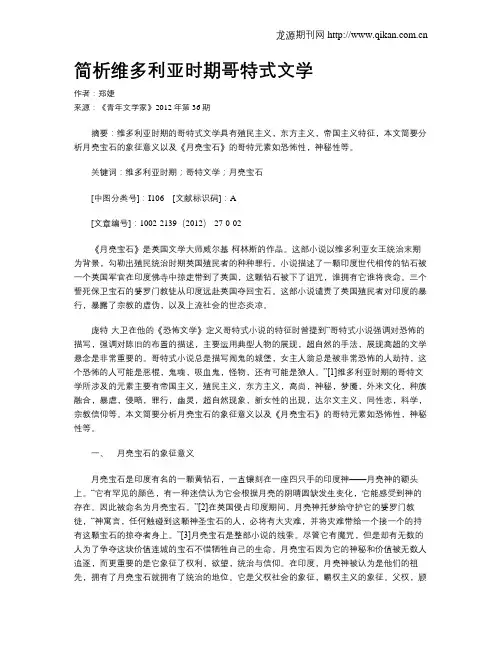
简析维多利亚时期哥特式文学作者:郑婕来源:《青年文学家》2012年第36期摘要:维多利亚时期的哥特式文学具有殖民主义,东方主义,帝国主义特征,本文简要分析月亮宝石的象征意义以及《月亮宝石》的哥特元素如恐怖性,神秘性等。
关键词:维多利亚时期;哥特文学;月亮宝石[中图分类号]:I106[文献标识码]:A[文章编号]:1002-2139(2012)-27-0-02《月亮宝石》是英国文学大师威尔基·柯林斯的作品。
这部小说以维多利亚女王统治末期为背景,勾勒出殖民统治时期英国殖民者的种种罪行。
小说描述了一颗印度世代相传的钻石被一个英国军官在印度佛寺中掠走带到了英国,这颗钻石被下了诅咒,谁拥有它谁将丧命。
三个誓死保卫宝石的婆罗门教徒从印度远赴英国夺回宝石。
这部小说谴责了英国殖民者对印度的暴行,暴露了宗教的虚伪,以及上流社会的世态炎凉。
庞特·大卫在他的《恐怖文学》定义哥特式小说的特征时曾提到“哥特式小说强调对恐怖的描写,强调对陈旧的布置的描述,主要运用典型人物的展现,超自然的手法,展现高超的文学悬念是非常重要的。
哥特式小说总是描写闹鬼的城堡,女主人翁总是被非常恐怖的人劫持,这个恐怖的人可能是恶棍,鬼魂,吸血鬼,怪物,还有可能是狼人。
”[1]维多利亚时期的哥特文学所涉及的元素主要有帝国主义,殖民主义,东方主义,高尚,神秘,梦魇,外来文化,种族融合,暴虐,侵略,罪行,幽灵,超自然现象,新女性的出现,达尔文主义,同性恋,科学,宗教信仰等。
本文简要分析月亮宝石的象征意义以及《月亮宝石》的哥特元素如恐怖性,神秘性等。
一、月亮宝石的象征意义月亮宝石是印度有名的一颗黄钻石,一直镶刻在一座四只手的印度神——月亮神的额头上。
“它有罕见的颜色,有一种迷信认为它会根据月亮的阴晴圆缺发生变化,它能感受到神的存在。
因此被命名为月亮宝石。
”[2]在英国侵占印度期间,月亮神托梦给守护它的婆罗门教徒,“神寓言,任何触碰到这颗神圣宝石的人,必将有大灾难,并将灾难带给一个接一个的持有这颗宝石的掠夺者身上。
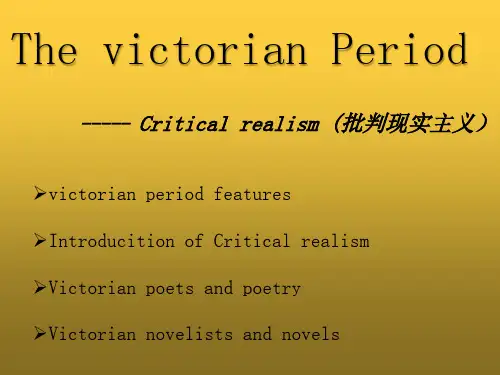
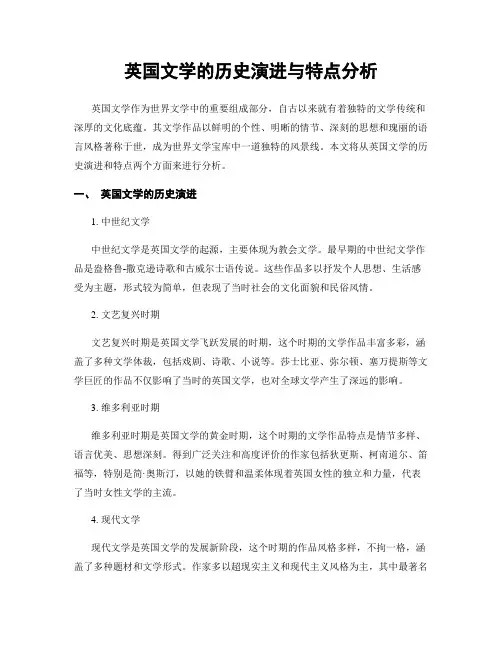
英国文学的历史演进与特点分析英国文学作为世界文学中的重要组成部分,自古以来就有着独特的文学传统和深厚的文化底蕴。
其文学作品以鲜明的个性、明晰的情节、深刻的思想和瑰丽的语言风格著称于世,成为世界文学宝库中一道独特的风景线。
本文将从英国文学的历史演进和特点两个方面来进行分析。
一、英国文学的历史演进1. 中世纪文学中世纪文学是英国文学的起源,主要体现为教会文学。
最早期的中世纪文学作品是盎格鲁-撒克逊诗歌和古威尔士语传说。
这些作品多以抒发个人思想、生活感受为主题,形式较为简单,但表现了当时社会的文化面貌和民俗风情。
2. 文艺复兴时期文艺复兴时期是英国文学飞跃发展的时期,这个时期的文学作品丰富多彩,涵盖了多种文学体裁,包括戏剧、诗歌、小说等。
莎士比亚、弥尔顿、塞万提斯等文学巨匠的作品不仅影响了当时的英国文学,也对全球文学产生了深远的影响。
3. 维多利亚时期维多利亚时期是英国文学的黄金时期,这个时期的文学作品特点是情节多样、语言优美、思想深刻。
得到广泛关注和高度评价的作家包括狄更斯、柯南道尔、笛福等,特别是简·奥斯汀,以她的铁臂和温柔体现着英国女性的独立和力量,代表了当时女性文学的主流。
4. 现代文学现代文学是英国文学的发展新阶段,这个时期的作品风格多样,不拘一格,涵盖了多种题材和文学形式。
作家多以超现实主义和现代主义风格为主,其中最著名的作家是约瑟夫·康拉德和D·H·劳伦斯,他们的作品向读者展示了英国作家的多元化风格和文化多样性。
二、英国文学的特点分析1. 丰富的文化底蕴英国文学有着深厚的文化底蕴,包括古代宗教、历史、传说、习俗、地理等方面的内容。
这些背景奠定了英国文学作品的独特性和瑰丽色彩。
在文学作品中,我们可以看到英国的地理景观、历史事件、风土人情等自然地融入到了作品之中。
2. 多元化的文学形式英国文学的多元化体现在不同的文学形式之中。
比如,诗歌、小说、戏剧等,每种文学形式都有其独特的创作手法和表现形式。
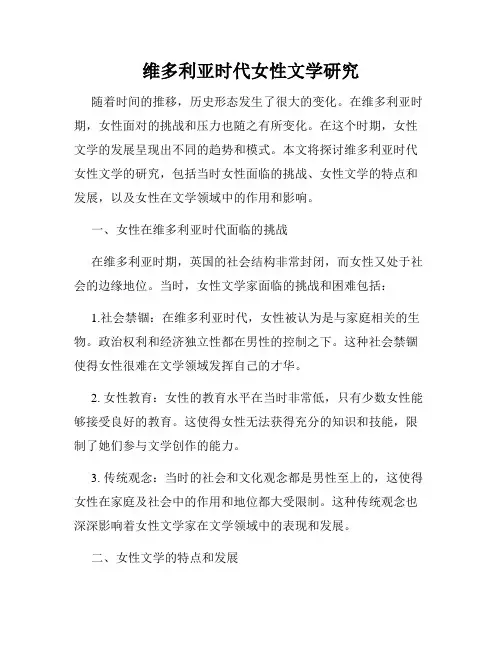
维多利亚时代女性文学研究随着时间的推移,历史形态发生了很大的变化。
在维多利亚时期,女性面对的挑战和压力也随之有所变化。
在这个时期,女性文学的发展呈现出不同的趋势和模式。
本文将探讨维多利亚时代女性文学的研究,包括当时女性面临的挑战、女性文学的特点和发展,以及女性在文学领域中的作用和影响。
一、女性在维多利亚时代面临的挑战在维多利亚时期,英国的社会结构非常封闭,而女性又处于社会的边缘地位。
当时,女性文学家面临的挑战和困难包括:1.社会禁锢:在维多利亚时代,女性被认为是与家庭相关的生物。
政治权利和经济独立性都在男性的控制之下。
这种社会禁锢使得女性很难在文学领域发挥自己的才华。
2. 女性教育:女性的教育水平在当时非常低,只有少数女性能够接受良好的教育。
这使得女性无法获得充分的知识和技能,限制了她们参与文学创作的能力。
3. 传统观念:当时的社会和文化观念都是男性至上的,这使得女性在家庭及社会中的作用和地位都大受限制。
这种传统观念也深深影响着女性文学家在文学领域中的表现和发展。
二、女性文学的特点和发展女性文学在维多利亚时代呈现出了独特的特点和发展,主要体现在以下几个方面:1. 文学主题:女性文学的主题主要涉及到女性的生活状态和心理状态的描写,例如爱情、家庭、社会地位等。
2. 文学形式:女性文学的形式呈现出较为柔和、幽雅、真实而凝重的特点。
通常采用第一人称叙述方式,通过女性视角来反映她们的生活状态和情感。
3. 文学语言:女性文学的语言通常采用深刻而真实的句子,表达的情感饱含内涵,具有特殊的感染力和感召力。
在当时的社会环境中,女性文学得以发展。
一些女性文学家,例如查尔蒂·勃朗特、伊丽莎白·贝瑞·博文和乔治·艾略特等人通过自己的才华和努力,取得了显著的成就。
她们的作品不仅让人们重新认识了女性,也为女性文学的发展铺平了道路。
三、女性在文学领域中的作用和影响在维多利亚时代,女性虽然处于社会的边缘地位,但是她们在文学领域中的作用和影响却不可忽视。
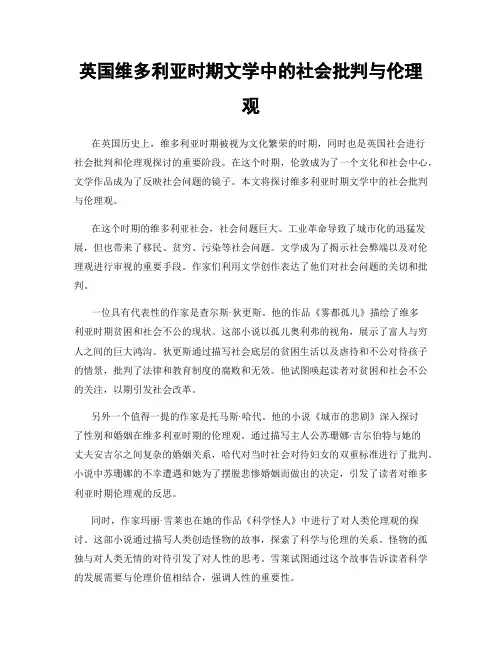
英国维多利亚时期文学中的社会批判与伦理观在英国历史上,维多利亚时期被视为文化繁荣的时期,同时也是英国社会进行社会批判和伦理观探讨的重要阶段。
在这个时期,伦敦成为了一个文化和社会中心,文学作品成为了反映社会问题的镜子。
本文将探讨维多利亚时期文学中的社会批判与伦理观。
在这个时期的维多利亚社会,社会问题巨大。
工业革命导致了城市化的迅猛发展,但也带来了移民、贫穷、污染等社会问题。
文学成为了揭示社会弊端以及对伦理观进行审视的重要手段。
作家们利用文学创作表达了他们对社会问题的关切和批判。
一位具有代表性的作家是查尔斯·狄更斯。
他的作品《雾都孤儿》描绘了维多利亚时期贫困和社会不公的现状。
这部小说以孤儿奥利弗的视角,展示了富人与穷人之间的巨大鸿沟。
狄更斯通过描写社会底层的贫困生活以及虐待和不公对待孩子的情景,批判了法律和教育制度的腐败和无效。
他试图唤起读者对贫困和社会不公的关注,以期引发社会改革。
另外一个值得一提的作家是托马斯·哈代。
他的小说《城市的悲剧》深入探讨了性别和婚姻在维多利亚时期的伦理观。
通过描写主人公苏珊娜·吉尔伯特与她的丈夫安吉尔之间复杂的婚姻关系,哈代对当时社会对待妇女的双重标准进行了批判。
小说中苏珊娜的不幸遭遇和她为了摆脱悲惨婚姻而做出的决定,引发了读者对维多利亚时期伦理观的反思。
同时,作家玛丽·雪莱也在她的作品《科学怪人》中进行了对人类伦理观的探讨。
这部小说通过描写人类创造怪物的故事,探索了科学与伦理的关系。
怪物的孤独与对人类无情的对待引发了对人性的思考。
雪莱试图通过这个故事告诉读者科学的发展需要与伦理价值相结合,强调人性的重要性。
维多利亚时期的作家们通过他们的作品对当时社会进行了深入的洞察,并试图引发社会批判和对伦理观的关注。
他们的作品不仅是文学佳作,更是对当时社会问题的呐喊和警示。
这些作品让读者思考社会问题和自身伦理观,促使社会进步和个人成长。
总之,维多利亚时期文学中的社会批判与伦理观是这个时期文学作品的重要特征。
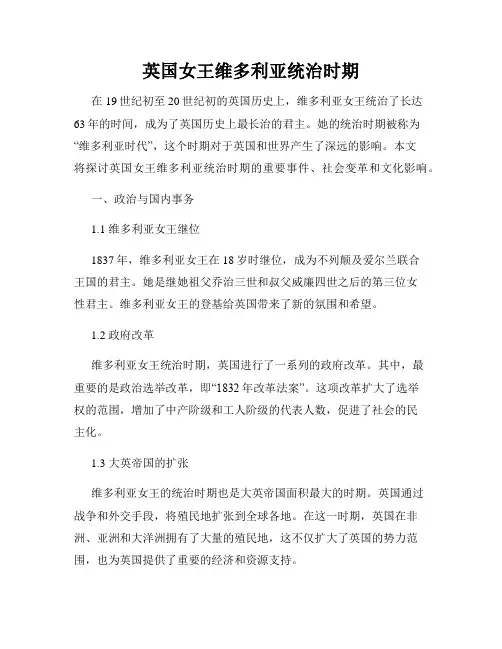
英国女王维多利亚统治时期在19世纪初至20世纪初的英国历史上,维多利亚女王统治了长达63年的时间,成为了英国历史上最长治的君主。
她的统治时期被称为“维多利亚时代”,这个时期对于英国和世界产生了深远的影响。
本文将探讨英国女王维多利亚统治时期的重要事件、社会变革和文化影响。
一、政治与国内事务1.1 维多利亚女王继位1837年,维多利亚女王在18岁时继位,成为不列颠及爱尔兰联合王国的君主。
她是继她祖父乔治三世和叔父威廉四世之后的第三位女性君主。
维多利亚女王的登基给英国带来了新的氛围和希望。
1.2 政府改革维多利亚女王统治时期,英国进行了一系列的政府改革。
其中,最重要的是政治选举改革,即“1832年改革法案”。
这项改革扩大了选举权的范围,增加了中产阶级和工人阶级的代表人数,促进了社会的民主化。
1.3 大英帝国的扩张维多利亚女王的统治时期也是大英帝国面积最大的时期。
英国通过战争和外交手段,将殖民地扩张到全球各地。
在这一时期,英国在非洲、亚洲和大洋洲拥有了大量的殖民地,这不仅扩大了英国的势力范围,也为英国提供了重要的经济和资源支持。
二、社会变革与经济发展2.1 工业革命的推进维多利亚时代是英国工业革命的高峰时期。
随着机械工业的兴起,英国的制造业和交通业迅速发展。
蒸汽机、纺织机械和铁路交通等技术的引入,使英国成为世界上第一大工业国家。
工业革命带来了大规模的城市化和人口迁移,改变了英国社会的面貌。
2.2 社会改革与劳工权益保护工业革命也引发了一系列的社会问题,包括工人阶级的贫困和劳动条件的恶劣。
为了改善这种状况,维多利亚时代进行了一系列的社会改革,包括通过法律来保护劳工权益,限制儿童劳动和改善工作环境。
这些改革为后来的劳动力法律奠定了基础。
2.3 女性权益的崛起维多利亚时代也见证了女性权益的崛起。
女性逐渐争取到更多的权益,包括教育和工作机会的获得。
著名的女权主义者艾米丽·潘克赫斯特通过抗议和政治运动,为女性争取了选举权,推动了社会对女性解放的思想。
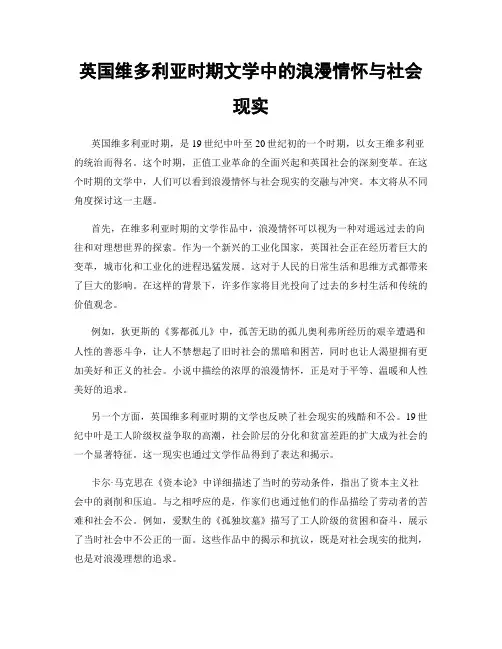
英国维多利亚时期文学中的浪漫情怀与社会现实英国维多利亚时期,是19世纪中叶至20世纪初的一个时期,以女王维多利亚的统治而得名。
这个时期,正值工业革命的全面兴起和英国社会的深刻变革。
在这个时期的文学中,人们可以看到浪漫情怀与社会现实的交融与冲突。
本文将从不同角度探讨这一主题。
首先,在维多利亚时期的文学作品中,浪漫情怀可以视为一种对遥远过去的向往和对理想世界的探索。
作为一个新兴的工业化国家,英国社会正在经历着巨大的变革,城市化和工业化的进程迅猛发展。
这对于人民的日常生活和思维方式都带来了巨大的影响。
在这样的背景下,许多作家将目光投向了过去的乡村生活和传统的价值观念。
例如,狄更斯的《雾都孤儿》中,孤苦无助的孤儿奥利弗所经历的艰辛遭遇和人性的善恶斗争,让人不禁想起了旧时社会的黑暗和困苦,同时也让人渴望拥有更加美好和正义的社会。
小说中描绘的浓厚的浪漫情怀,正是对于平等、温暖和人性美好的追求。
另一个方面,英国维多利亚时期的文学也反映了社会现实的残酷和不公。
19世纪中叶是工人阶级权益争取的高潮,社会阶层的分化和贫富差距的扩大成为社会的一个显著特征。
这一现实也通过文学作品得到了表达和揭示。
卡尔·马克思在《资本论》中详细描述了当时的劳动条件,指出了资本主义社会中的剥削和压迫。
与之相呼应的是,作家们也通过他们的作品描绘了劳动者的苦难和社会不公。
例如,爱默生的《孤独坟墓》描写了工人阶级的贫困和奋斗,展示了当时社会中不公正的一面。
这些作品中的揭示和抗议,既是对社会现实的批判,也是对浪漫理想的追求。
此外,在维多利亚时期的文学中,浪漫情怀与社会现实也在一定程度上相互融合。
作家们展示了他们对于浪漫情感的追求,同时又展示了他们对眼见的现实问题的关注。
笔者认为,正是这种融合,使得维多利亚时期的文学作品充满了深度和深远的意义。
浪漫情怀让文学作品充满了理想主义和人性美好的追求,而对社会现实的揭示和关注,则保证了作品的现实性和价值。
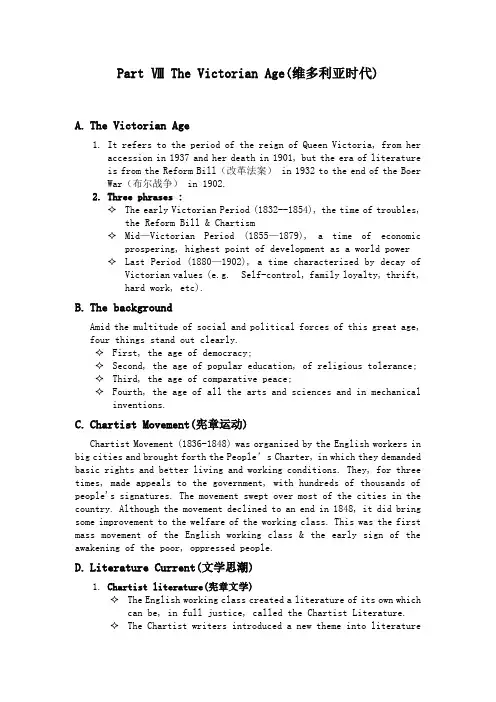
Part Ⅷ The Victorian Age(维多利亚时代)A.The Victorian Age1.It refers to the period of the reign of Queen Victoria, from heraccession in 1937 and her death in 1901, but the era of literature is from the Reform Bill(改革法案) in 1932 to the end of the Boer War(布尔战争) in 1902.2.Three phrases :✧The early Victorian Period (1832--1854), the time of troubles,the Reform Bill & Chartism✧Mid—Victorian Period (1855—1879), a time of economicprospering, highest point of development as a world power✧Last Period (1880—1902), a time characterized by decay ofVictorian values (e.g. Self-control, family loyalty, thrift,hard work, etc).B.The backgroundAmid the multitude of social and political forces of this great age, four things stand out clearly.✧First, the age of democracy;✧Second, the age of popular education, of religious tolerance;✧Third, the age of comparative peace;✧Fourth, the age of all the arts and sciences and in mechanicalinventions.C.Chartist Movement(宪章运动)Chartist Movement (1836-1848) was organized by the English workers in big cities and brought forth the People’s Charter, in which they demanded basic rights and better living and working conditions. They, for three times, made appeals to the government, with hundreds of thousands of people's signatures. The movement swept over most of the cities in the country. Although the movement declined to an end in 1848, it did bring some improvement to the welfare of the working class. This was the first mass movement of the English working class & the early sign of the awakening of the poor, oppressed people.D.Literature Current(文学思潮)1.Chartist literature(宪章文学)✧The English working class created a literature of its own whichcan be, in full justice, called the Chartist Literature.✧The Chartist writers introduced a new theme into literature— the struggle of the proletariat(无产阶级) for its rights.✧Some great Chartist poets are Ernest Jones (1819-1869), ThomasCooper (1805-1892), and William James Linton (1812-1897).2.Critical Realism(批判现实主义文学)✧Critical Realism is one of the literary genres that mainlyflourished in the 40s and in the early 50s in the 19th century.The critical realists not only gave the criticism tobourgeoisie and all ruling classes, bur also showed their deepsympathy for the common people. Hence humor and satire aboundin the English realistic novels of the 19th century. But thecritical realists did not find a way to eradicate(根除) socialevils. They did not realize the necessity of changing thebourgeois society. They were unable to find a good solutionto the social contradictions. The chief tendency in their worksis not of revolution but rather of reformism. Here we see atonce the strength and the weakness of critical realism. Threegreatest representatives of Critical Realism are CharlesDickens(狄更斯), William Makepeace Thackeray(萨克雷), andGeorge Eliot(艾略特). E.………………………………………………………………………………………………. F.…………………………………………………………………………………………………G.………………………………………………………………………………………………….H.Some Exercises1.The precisian may limit the Victorian period to the years betweenthe Queen’s accession in 1837 and her death in 1901, but a newera really began with the passage of the Reform Bill in 1832 andclosed at the end of the Bore war in 1902.2.Victorian literature, as a product of its age, naturally took onits quality of magnitude and diversity. It was many-sacked andcomplex, and reflected both romantically and realistically thegreat changes that were going on in people’s life and thought.3.In the 19th century English literature, a new literary trendcritical realism appeared after the romantic poetry, andflourished in the 40s and in the early 50s.4.Critical realism found its expression in the form of novel; mostof the critical realists were novelists.5.Critical realism reveals the corrupting influence of the rule ofcash upon human nature. Here lies in the essentially democraticand humanistic character if critical realism.6.The Chartist Movement appeared in the 30s of the 19th century.7.The most important poet of the Victorian Age was Tennyson, nextto him, were Robert Browning and his wife.8.The Chartist writers introduced a new theme into literature: thestruggle of the proletariat for its rights.9.The Chartist poetry played an important role in the developmentof English proletariat literature; the greatest Chartist poet was Ernest Jones. I..............................................................................J.Charles Dickens(狄更斯)A.LifeCharles Dickens (1812--1870) was born in a poor family in the Portsmouth. He gave up schooling to work after his father was put into the prison because of the debt. In 1870, he died of overwork.B.The three period of his literary career1.the first period of youthful optimismAt this stage Dickens believed that all the evils of the capitalist world would be remedied if only men behaved to each other with kindliness, justice, and sympathetic understanding.Main works in this period:Sketches by Boz 《博兹随笔》Pickwick Paper 《匹克威克外传》Oliver Twist 《雾都孤儿》Nicholas Nickleby 《尼古拉斯尼克贝》Old Curiosity Shop 《老古玩店》Barnaby Rudge 《巴纳比卢杰》2.the second period of excitement & irritationDickens' second period began from 1842, the year after his first visit to America.Main works in this period:American Notes 《美国札记》Martin Chuzzlewit 《马丁朱杰尔维特》A Christmas Carol 《圣诞欢歌》The Chimes 《钟声》The Cricket on the Hearth 《炉边蟋蟀》Dombey and Son 《董贝父子》David Copperfield 《大卫科波菲尔》3.the third period of steadily intensifying pessimismThe last period of Dickens's literary career began with the publication of "Bleak House" in 1852-1853.Up to this time Dickens maintained some hope of reform under capitalism but beginning from "Bleak House" there was an "underlying tone of bitterness" which showed the novelist's loss of hope for English bourgeois society.Main works in this period:Bleak House《荒凉山庄》Hard Time《艰难时世》Little Dorrit《小杜丽》A Tale of Two Cites《双城记》Great Expectations 《远大前程》Our Mutual Friend 《我们共同的朋友》Edwin Drood(unfinished) 《埃德温多鲁德》C.Distinct Features of His Novels(1) Character Sketches & Exaggeration(2) Broad Humor & Penetrating Satire(3) Complicated & Fascinating Plot(4) The Power of Exposurements of DickensCharles Dickens is one of the greatest critical realistic writers of the Victorian Age.In his works, Dickens sets a full map & a large-scale criticism of the 19th-century England, particularly London..Characterization is the most outstanding feature of his works.Dickens also employs exaggeration in his works.Yet he is a petty bourgeois intellectual. He could not overstep the limits of his class. He failed to see the necessity of a bitter struggle of the oppressed against their oppressors.E.Some works1.The Pickwick Papers《匹克威克外传》Plot2.Oliver Twist 《雾都孤儿》PlotThe novel tells the story of a poor child named Oliver Twist. He is born in a workhouse and brought up under miserable conditions.After experiencing an unhappy apprenticeship to an undertaker, he runs away to London, where he falls into the hands of a gang of thieves.Then he is made to be a pickpocket. A benevolent rich old man called Mr. Brownlow rescues him and takes him home, but the thieves kidnap him and make him join them once again. A bad person named Monks, who turns out to be Oliver’s half-brother, helps the thieves in keeping Oliver in the gang, in order to ruin him and obtain the whole of his father’s property. Then Oliver i s made to help one the thieves in breaking into a lady’s house. He gets wounded, and comes into the hands of her aunt. Finally the thieves in the gang are punished and Oliver’s half brother is compelled to confess his evil doing and put into prison. Oliver is adopted by Mr. Brownlow.F.Some exercises1. Charles Dickens was the greatest representative of English Critical Realism.2. Of all of Dickens’s novels, David Copperfield is regarded as his masterpiece.3. In A Tale of Two Cities, the two cities are London and Paris in the time of revolution.4. The novel Nicholas Nickleby touches upon a burning question of Dickens’s time; the education of children in the private schools.5. The novel Oliver Twist tells the story of a poor child named Oliver Twist who was born in a workhouse and brought up under miserable conditions.6. The novel Hard Times makes a fierce attack on the bourgeois systemof education and the bourgeois philosophy Utilitarianism.G.OthersWilliam Makepeace Thackeray(萨克雷)A.His worksThe Books of Snobs 《势力人》Vanity Fair《名利场》Pendennis 《潘丹尼斯的历史》The Newcomers《纽卡母一家》The Rose and the Ring (fairy tale) 《玫瑰与戒指》(通话)Henry Esmond《亨利·艾斯芒德》The Virginians (historical novels) 《弗吉尼亚人》B.Characteristics of Thackeray’s novels1.William Makepeace Thackeray is one of the greatest critical realists of the 19th century.The pictures in his novels are accurate and true to life. He is good at describing the life of the upper class with which he is familiar.2.Thackeray is a satirist.3.He is a moralist. His aim is to produce a moral impression in all his novels.C.Vanity Fair《名利场》1.The Origin of the TitleThis title was borrowed by Thackeray from The Pilgrim’sProgress (天路历程) by Bunyan. It means “a fair, wherein aresold all sorts of vanity.”2.The Implication of the Subtitle----Novel Without a Hero✧No exactly positive character✧About women instead of men✧Not about some particular person but about the society3.Theme of the novelIn this novel Thackeray describes the life of the upper class of England in the early decade of the 19th century, and attacks the social relationship of the bourgeois world by satirizing the individual in the different strata of the upper society. It is a world where money grubbing is the main motive for all members of the upper class.4. Characters: A brief comment on Amelia and Becky in Vanity Fair In Vanity Fair Thackeray successfully characterizes two heroines who stand in contrast in their characters and attitudes towards life.Amelia is a character of milk-and-water type, good in nature, tame and moral, sentimental and sympathetic, but unable to master her own fate. Becky, who is more impressively character and can be said to be the real heroine of the novel in a way, is different from Amelia;she is crafty, unscrupulous, and resourceful and she is neverobedient to her destiny and always rebels in order to have a change in her life, regardless of morality and the social judgment of her.The two heroines are, to Thackeray, the victims of the social environment that is inhuman in its nature.5.D.Some exercise1.In 1847, Thackeray published his masterpiece Vanity Fair, whichmarks the peak of his literary career.2.The sub-title of Vanity Fair is Novel without a Hero. The writer’sintention was not to portray individuals, but bourgeois and aristocratic society as a whole.3.The main plot of Vanity Fair renders on the story of two women:Amelia Sedlley and Rebecca Sharp, whose characters are sharp contrast.E.othersGeorge Eliot(爱略特)----Pseudonym of Mary Ann Evans.A.Her Works✧Scenes of Clerical Life 《教区生活场景》✧Adam Bede《亚当贝德》✧Mill on the Floss《弗洛斯河上的磨坊》✧Silas Marner《织工马南》✧Middlemarch《米德尔马奇》✧需要补充B.Some exercises1.George Eliot was the Pseudonym of Mary Ann Evans.2.The author of The Mill on the Floss is George Eliot.3.George Eliot produced three remarkable novels including Adam Bede,The Mill on the Floss and Silas Marner.4.In the novel Adam Bede, Adam falls in love with a village girl calledHetty Sorrel who is seduced and deserted by a squire.C.OthersCharlotte Bronte and Emily Bronte(夏洛特和爱米丽)A.Works of Bronte Sisters✧Charlotte Bronte Professor《教授》Jane Eyre《简·爱》Shirley《雪丽》Villette.《维莱特》✧Emily Bronte Wuthering House《呼啸山庄》✧Ann Bronte Agnes Grey 《安格尼斯·格雷》The Tenant of Wildfell Hall《维尔德·霍的佃户》B.Jane Eyre1.The theme of the novel✧The criticism of the bourgeois system of education✧The position of the women in society ---- the women should theequal rights with men2.The limitation of the novelCharlotte believes that education is the key to all social problems, and that by the improvements of the school system, mostof the social evils could be removed.3.Why the novel is greatly admired?1) Jane’s characteristics.2) Jane’s treatment of her love and marriage.Jane, differentfrom many other women in the mammon worship society, considersmarriage not as a bargain but as a union of kindred souls.3) Jane sticks to her principles, successfully resists theoppression and other social evils in the inhuman world andacquires her own happiness.4) It contains the author’s criticism of bourgeois attitudetoward marriage and love, and her ruthless expose of inhumanmisery in charity schools of her days which were establishedand run in the name of philanthropy. She attacks the terribleeducational system in her day and points out the miserable fateof poor girls as charity school pupils and as governess.4.C.Wuthering HouseD.Some exercises1.The Bronte sisters are Charlotte Bronte, Emily Bronte and AnnBronte.2.Charlotte Bronte’s masterpiece is Jane Eyre.3.Emily Bronte’s masterpiece is Wuthering House.E.维多利亚女王维多利亚女王是第一个以“大不列颠与爱尔兰联合王国女王和印度女皇”名号称呼的英国君主。

维多利亚时期的英国文学(考研资料)English literature in the 20th century20世纪的英国文学1. Historical BackgroundHistorically:Modernism rose out of skepticism and disillusion of capitalism. The First World War and the Second World War had greatly influenced the English literature.Economically:The Second World War marked the last stage of the disintegration of the British Empire. Britain suffered heavy losses in the war: thousands of people were killed; the economy was ruined; and almost all its former colonies were lost. People were in economic, cultural, and belief crisis. Frequent economic depressions and mass unemployment sharpened the contradictions between the rich and the poor.Ideologically:The rise of the irrational philosophy and new science greatly incited modern writers to make new explorations on human natures and human relationships. (Scientific Socialism, Social Darwinism)2. Artistic features of modern periodRealismRealism was, to a certain extent, eclipsed by the rapid rise of modernism in the 1920s.In the 1930s, novelists began to turn their attention to the urgent social problems. They also enriched the traditional ways of creation by adopting some modernist techniques. However, the realist novels of this period were more or less touched by apessimistic mood, preoccupied with the theme of man’s loneliness, and shaped in different forms: social satires by Aldous Huxley and George Orwell, comic satires on the English upper class by Evelyn Waugh; and Catholic novels by Graham Greene.The Angry Young Man: A group of young novelists and playwrights with lower-middle-class or working-class background in the mid-1950s and early 1960s.They demonstrated a particular disillusion幻灭over the depressing situation in Britain and launched a bitter protest against the outmoded过时的social and political values in their society. Kingsley Amis was the first to start the attack on the middle-class privileges and power in his novel Lucky Jim (1954). The term “The Angry Young Man” came to be widely used. Having been merged and interpenetrated with modernism in the past several decades, the realistic novels of the 1960s and 1970s appeared in a new face with a richer, more vigorous and more diversified style.二十世纪英国现实主义文学改变了维多利亚时代那种高雅温和的倾向,加强了对英国社会的保守性和虚伪性的批判,具有一种冷峻地直面人生的特点。
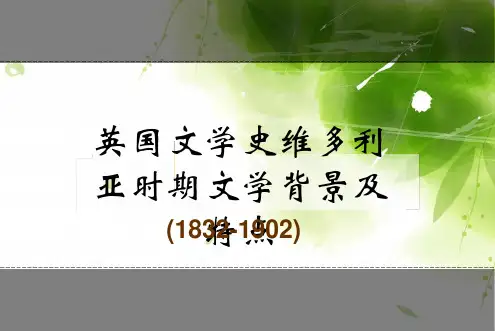
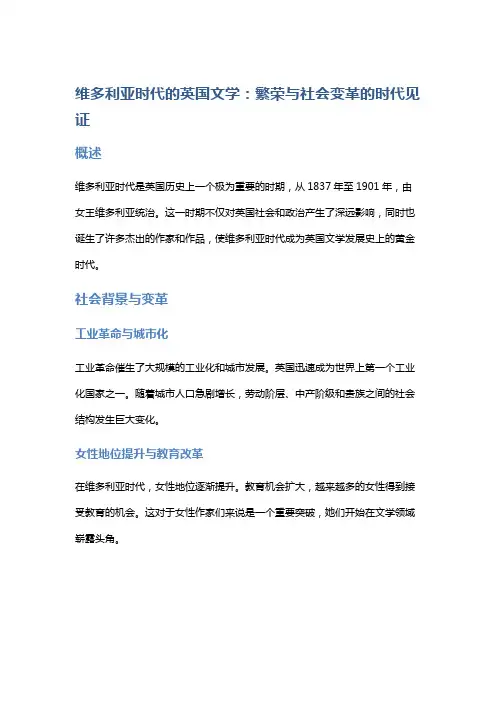
维多利亚时代的英国文学:繁荣与社会变革的时代见证概述维多利亚时代是英国历史上一个极为重要的时期,从1837年至1901年,由女王维多利亚统治。
这一时期不仅对英国社会和政治产生了深远影响,同时也诞生了许多杰出的作家和作品,使维多利亚时代成为英国文学发展史上的黄金时代。
社会背景与变革工业革命与城市化工业革命催生了大规模的工业化和城市发展。
英国迅速成为世界上第一个工业化国家之一。
随着城市人口急剧增长,劳动阶层、中产阶级和贵族之间的社会结构发生巨大变化。
女性地位提升与教育改革在维多利亚时代,女性地位逐渐提升。
教育机会扩大,越来越多的女性得到接受教育的机会。
这对于女性作家们来说是一个重要突破,她们开始在文学领域崭露头角。
社会道德与宗教信仰维多利亚时代强调社会道德和宗教信仰的重要性,这在一定程度上影响了当时的文学创作。
作家们通过描绘生活中的困境、道德冲突和宗教矛盾来探讨人类行为与伦理的问题。
主要作家与作品查尔斯·狄更斯(Charles Dickens)狄更斯是维多利亚时代最知名也最受欢迎的小说家之一。
他以其真实而生动的描写风格,揭示了工业革命带来的社会问题,并关注弱势群体面临的挑战。
他的代表作品包括《雾都孤儿》、《双城记》和《大卫·科波菲尔》等。
爱丽丝·门罗(Alice Munro)门罗是一位杰出的短篇小说家,在维多利亚时代末期取得了重要成就。
她以其精确而充满人性关怀的写作风格而闻名,通过深入剖析个体经历来探索女性在当时社会中所面临的限制和挑战。
奥斯卡·王尔德(Oscar Wilde)王尔德是一位才华横溢的剧作家和小说家,他的作品糅合了幽默和深刻的社会评论。
他以描绘上层社会世界为主题,对当时的道德观念进行嘲讽和挑战。
他的代表作品包括《道林·格雷的画像》和《重要的是不太认真》等。
文学特点与影响社会写实主义与评论性维多利亚时代文学注重真实记录生活,特别关注社会问题和阶级差异。
维多利亚时期Chapter 4 The Victorian Period一。
学习目的和要求通过本章的学习,对19世纪维多利亚时代英国的政治,经济,历史,文化背景,对维多利亚时代的诗歌,散文,小说在创作思想上的进步和创作技巧上的改革,以及对该时代主要作家的生平,观点,创作旨意,艺术品特点及其代表作的主题,结构,语言,人物刻画等都有一个全面的了解。
并通过作品选读加深体会感受,增强对作品的理解和鉴赏能力。
二。
考核要求(一)维多利亚时期概述1. 识记:(1)维多利亚时期的界定(2)社会政治,经济,文化背景。
2. 领会:(1)维多利亚时期的文学特点(2)批判现实主义小说对后世文学的影响。
3. 应用:宪章运动,功利主义,批判现实主义,戏剧独自等名词的解释(二)该时期的重要作家1. 一般识记:重要作家的生平与创作生涯2. 识记:重要作品及主要内容3. 领会:重要作家的创作思想,艺术特色及其代表作品的主题思想,人物塑造,语言风格,社会意义等。
4. 应用:(1)狄更斯和萨克雷作品的批判现实主义思想及各自的创作手法,艺术特色。
(2)小说《简。
爱》,《呼啸山庄》的主题思想与人物塑造。
(3)"我逝去的公爵夫";中的戏剧独白。
(4)乔泊。
艾略特和哈代小说中环境,氛围描述与人物内世界的展示。
A. Introduction to the Victorian Period1. 识记(1)Definition:the Victorian PeriodChronologically the Victorian period roughly coincides with the reign of Queen Victoria who ruled over England from 1836 to 1901. The period has been generally regarded as one of the most glorious in the English history.(2)Political,Economical & Cultural BackgroundThe early years of the Victorian England was a time of rapid economic development as well as serious social problems. After the Reform Bill of 1832 passed the political power from the decaying aristocrats into the hands of the middle-class industrial capitalists,the Industrial Revolution soon geared up. Towards the mid-century,England had reached its highest point of development as a world power. And yet beneath the great prosperity & richness,there existed widespread poverty & wretchedness among the working class. The worsening living & working conditions,the mass unemployment & the new Poor Law of 1834 with its workhouse system finally gave rise to the Chartist Movement (1836-1848)。
维多利亚时期的女性文学
维多利亚时期的女性文学
在西方的历史中对女性一直有一种极端不公平的观点,那就是有女性承担了“原罪”。
在《圣经》中,夏娃没有经受住蛇的诱惑,吃下了智慧果,所以人类才从伊甸园迁了出来。
从这里开始,女性就是一种负面的形象。
再来看希腊神话中“潘多拉”的形象,她外表美丽,但内心邪恶,带来了一切的灾难。
在中国汉字中也有“女主阴”的概念。
在西方文学中女性都是应该在家相夫教子的,不应该有文化。
女性文学繁荣的原因有以下几点
1英国在19世纪经历了第二次工业革命之后经济飞速发展,对人力的要求极大,而当时英国的男性已经无法满足需要了,于是女性纷纷从家中走出来帮助男性进行工作。
2英国政府当时出台了一系列的法案去保护妇女权益,鼓励女性受教育。
3再受教育之后,女性有了话语权,就开始为自己的形象而辩护。
当时的几个问题
1女性虽然走进社会,但却没有一个完整的条例。
这导致了男女性同工不同酬的现象出现。
而且对于女性所需的假期也没有规定。
2女性虽然受到教育,但很大一部分都是“淑女教育”,没有实质上的作用。
3当时人们心里根深蒂固的细想决定了女性的形象。
当时作家笔下的女性形象不外乎两种,一种是“蛇蝎美人”,一种是“居家好女人”。
奴性文学的主体意识
1要控诉男性的压迫,社会的歧视。
2塑造不同于传统规范的争取独立,自由的女性形象。
3表现对爱情的深刻理解和感受。
维多利亚时代的女性解放与文学概述维多利亚时代(1837年-1901年)是英国历史上的一个重要时期,其特点是道德感、保守主义和男性至上的观念盛行。
然而,在这个时代里,女性逐渐开始追求解放和参与社会活动。
在文学领域中,维多利亚时代也见证了女性大胆发声、表达自我和探索自身角色的重要里程碑。
女性解放运动发展背景1.社会地位:在维多利亚时代早期,女性被视为家庭生活的中心,她们的社会地位受到限制。
2.教育机会:女性教育局限于家庭和家务工作,并未得到公平的教育机会。
3.政治权利:女性在政治上没有投票权和参与权。
文学对女性解放运动的影响1.作家在小说中描述了对女性角色的束缚和不公正待遇,揭示了社会结构中存在的问题。
2.通过刻画强烈意志、勇于挑战传统束缚、追求个人价值观的女主人公,鼓励其他女性追求解放。
3.文学作品启发了女性读者的思考,激发了她们要求平等权利和社会地位的欲望。
重要作家与他们的作品1.查尔斯·狄更斯:《尘世飞花》中刻画的英勇善良、对抗不公正对待并争取自由权利的卡罗琳娜女主角影响深远。
2.夏洛蒂·勃朗特:《简爱》通过塑造独立、坚强且追求自由的简·爱来展现女性对传统束缚说“不”的精神。
3.乔治·艾略特:《米德尔马奇》中展示了才华出众但受到社会禁锢束缚的多萝西娅,并借其形象呼吁女性应该有更广阔的发展机会。
女性解放的成果1.维多利亚时代末期,女性逐渐获得接受教育和职业机会等平等权益。
2.1894年成立了英国妇女选民联合会(NUWSS),为妇女参政提供了一个强大的组织力量。
3.1902年,英国通过《巴里特-布朗威尔法案》,部分解除了对已婚妇女财产权的限制。
总结维多利亚时代的女性解放与文学密切相关。
作家们通过创作塑造了坚强、自主和无畏的女性形象,启发了无数女性追求平等和自由。
女性运动取得了一系列成果,为后来的人权运动奠定了基础,并为现代社会的性别平等做出了重要贡献。
以上内容旨在概述维多利亚时代至于女性解放与文学之间的关系,提供基本信息和指导读者进一步探索该主题。
The characteristics of novels in the Victoria times
姓名:王国艳学号:201352010523 班级:英语5班
The Reform Billof 1832 gave the middle class the political power it needed to consolidate—
and to hold—the economic position it had already achieved. Industry and commerce
burgeoned. While the affluence of the middle class increased, the lower classes, throwing off
their land and going into the cities to form the great urban working class, lived ever more
wretchedly. The social changes were so swift and brutal that Godwin Ian utopianism rapidly
gave way to attempts either to justify the new economic and urban conditions, or to change
them. The intellectuals and artists of the age had to deal in some way with the upheavals in
society, the obvious inequities of abundance for a few and squalor for many, and, emanating
from the throne of Queen Victoria (1837–1901), an emphasis on public rectitude and moral
propriety.
The Novel
The Victorian era was the great age of the English novel—realistic, thickly plotted, crowded wi
th characters, and long. It was the ideal form to describe contemporary life and to entertain the
middle class. The novels of Charles Dickens,
Full to overflowing with drama, humor, and an endless variety of vivid characters and plot com
plications, nonetheless spares nothing in their portrayal of what urban life was like for all classes.
William Makepeace Thackeray is best known for Vanity Fair (1848), which wickedly satirizes hyp
ocrisy and greed.
Emily Brontë's (see Brontë, family) single novel, Wuthering Heights (1847), is a unique masterp
iece propelled by a vision of elemental passions but controlled by an uncompromising artistic sen
se. The fine novels of Emily's sister Charlotte Brontë, especially Jane Eyre (1847) and Villette (185
3), are more rooted in convention, but daring in their own ways. The novels of George Eliot (M
ary Ann Evans) appeared during the 1860s and 70s. A woman of great erudition and moral fervo
r, Eliot was concerned with ethical conflicts and social problems. George Meredith produced co
mic novels noted for their psychological perception. Another novelist of the late
19th cent. Was the prolific Anthony Trollope, famous for sequences of related novels that explor
e social, ecclesiastical, and political life in England?
Thomas Hardy's profoundly pessimistic novels are all set in the harsh; punishing Midland
County he called Wessex. Samuel Butler produced novels satirizing the Victorian ethos, and Rob
ert Louis Stevenson, a master of his craft, wrote arresting adventure fiction and children's verse. T
he mathematician Charles Lutwidge Dodgson, writing under the name Lewis Carroll, produced t
he complex and sophisticated children's classics Alice's Adventures in Wonderland (1865) and Thr
ough the Looking Glass (1871). Lesser novelists of considerable merit include Benjamin Disraeli, G
eorge Gissing, Elizabeth Gaskell, and Wilkie Collins. By the end of the period, the novel was cons
idered not only the premier form of entertainment but also a primary means of analyzing and of
fering solutions to social and political problems.
Nonfiction
Among the Victorian masters of nonfiction were the great Whig historian Thomas Macaulay
and Thomas Carlyle, the historian, social critic, and prophet whose rhetoric thundered through
the age. Influential thinkers included John Stuart Mill, the great liberal scholar and philosopher;
Thomas Henry Huxley, a scientist and popularize of Darwinian Theory; and John Henry,
Cardinal Newman, who wrote earnestly of religion, philosophy, and education. The founders
of Communism, Karl Marx and Friedrich Engels, researched and wrote their books in the free
environment of England. The great art historian and critic John Ruskin also concerned himself
with social and economic problems. Matthew Arnold's theories of literature and culture laid the
foundations for modern literary criticism, and his poetry is also notable.